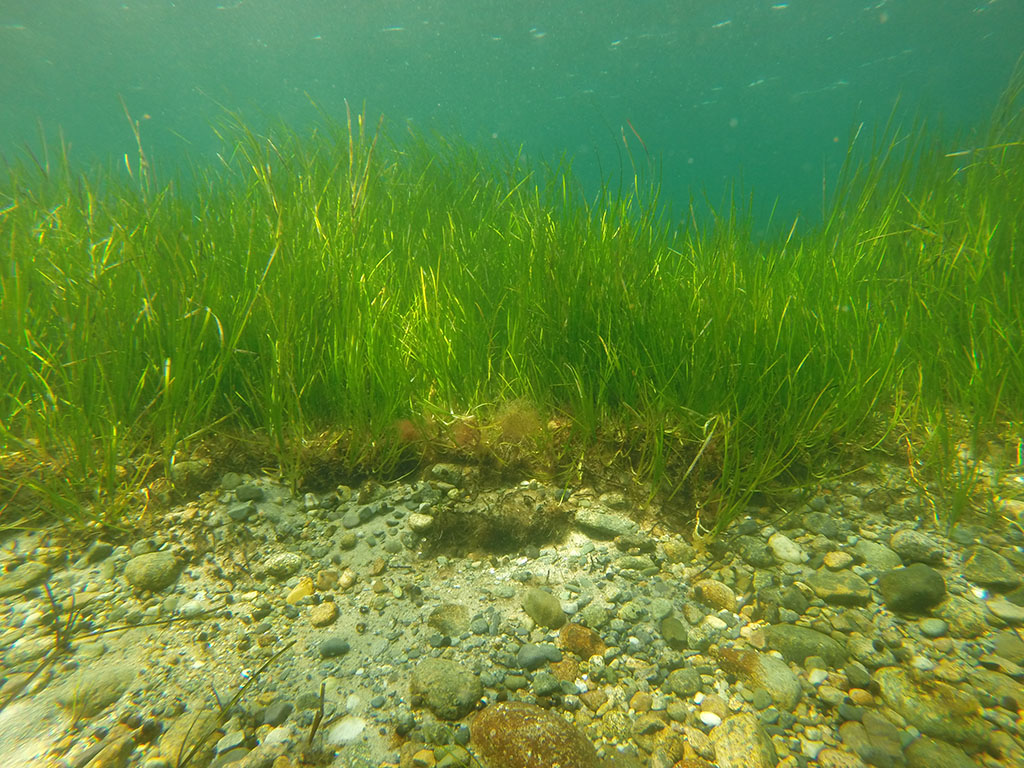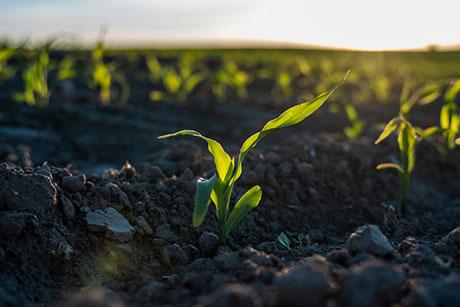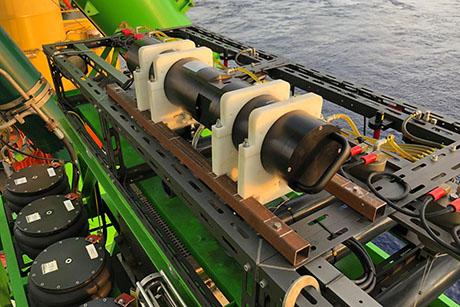Green Eelgrass, Blue Carbon
MIT Sea Grant is working with several partners to quantify the carbon storage of eelgrass beds in Massachusetts.
By understanding the role that eelgrass ecosystems play in preparing for and mitigating the effects of climate change we can better make the case for securing protection and restoration resources.
Seagrasses are aquatic plants, marine grasses that evolved on land with other grasses and later migrated back to the coastal ocean. Our local species here in Massachusetts is eelgrass, or Zostera marina. If you look closely, eelgrass resembles the grass from your lawn, with long flat blades, shallow roots and flowers.
Eelgrass beds spread out and form meadows, which help tie down sediments, improving water clarity and reducing shoreline erosion. Just like a terrestrial meadow, eelgrass meadows are teeming with life. They provide a safe place for marine animals to lay eggs, a nursery habitat for young fish, and protection from predators for young animals like scallops, crabs, and lobsters. Eelgrass meadows also play an important part in improving water quality by recycling nutrients in runoff from land.
More recently, seagrass beds in tropical regions have been recognized as an important natural carbon sink, storing a large amount of carbon in both the plant tissue and in the sediments the beds help collect. Carbon storage and sequestration by coastal marine ecosystems, often called "blue carbon," is best understood in habitats such as mangroves, salt marshes and seagrass meadows. The carbon storage capacity of seagrass meadows is the least well quantified of these coastal habitats. Very little is known about the capacity of eelgrass meadows in temperate regions, like the Northeast.
MIT Sea Grant is working with the Environmental Protection Agency (EPA), researchers at Boston University, the Massachusetts Division of Marine Fisheries, and the Massachusetts Bays National Estuary Program (MassBays) to conduct studies to quantify the carbon storage of eelgrass beds in coastal Massachusetts. Field surveys were done during summer months in the height of the eelgrass growing season, from five eelgrass beds in Massachusetts. Divers suited up to take sediment cores inside and outside eelgrass meadows and collected samples of eelgrass. A shore team set up under an umbrella to process the cores, water samples, and plant tissues as the divers brought them up. Blade characteristics such as length, presence of seeds, and presence of invasive tunicates were recorded. Samples were then packed up and sent to labs for analysis.
The study found that eelgrass meadows in coastal waters around Massachusetts hold the same amount of carbon or more as researchers have documented in other studies in and around the North Atlantic. Unsurprisingly, the study also gave some key evidence to support the common knowledge that sediment in eelgrass beds has more carbon than sediments without eelgrass cover. Stable isotope analysis of the sediment gave fascinating insights into just where the carbon that is being held comes from. Initial analysis identified that the carbon originates from both the eelgrass plants themselves, and, perhaps more importantly, also from phytoplankton and other floating particles in the water. This means that eelgrass meadows have the capacity to capture and store carbon from outside sources, increasing the potential amount of carbon they are able to sequester to more than what the meadows produce.
These results offer insight into the important ecosystem services eelgrass meadows provide. The study also has the potential to make significant impacts in how regulatory agencies view eelgrass meadows. As a whole, mangrove, salt marsh, and seagrass ecosystems are estimated to be disappearing from 2 to 15 times faster than terrestrial forests. Human activities are causing local eelgrass beds to disappear at a disturbing rate. Quantifying carbon storage potential in local eelgrass beds provides a valuable tool for assessing carbon stocks and highlighting priority areas for conservation.
MIT Sea Grant and MassBays are working together to develop outreach materials targeting community members that have an impact on eelgrass beds. These materials will help local conservation boards to understand their role in protecting these valuable coastal habitats, encourage beach goers to appreciate and explore eelgrass beds without harming them, and help teachers develop curricula where students can use real data to calculate carbon storage potential. Materials will be available this fall on the MIT Sea Grant website.
The work was carried out by a team of researchers that included: EPA Region 1, MIT Sea Grant, Massachusetts Bays National Estuary Program, Boston University, Suffolk University, and Massachusetts Division of Marine Fisheries with funding from the U.S. Environmental Protection Agency Climate Ready Estuaries Program, the McNair Scholars Program, and MIT Sea Grant.



